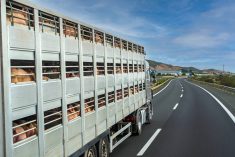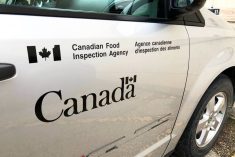A Prairie manufacturer of pre-engineered, fabric-covered shelters used for livestock barns and crop storage has folded its tent and is expected to sell off its assets next month.
And Calgary-based Cover-All Building Systems, which went into creditor protection March 24, now urges owners of its buildings to bring in engineers to make sure they meet the relevant building codes.
A notice of motion filed last week and approved April 23 in Court of Queen’s Bench in Calgary reports lenders for Cover-All “have come to the conclusion that the most efficient way to move forward would be through a receivership proceeding.”
Read Also

U.S. livestock: ‘Cattle on feed’ report supports prices
Chicago cattle futures rose as the USDA’s ‘Cattle on Feed’ report showed inventories two per cent down from a year…
PricewaterhouseCoopers (PwC) has been named as Cover-All’s receiver and granted authority to sell the company’s eligible assets.
The court-approved schedule of events calls for the company’s property and assets to be put up for sale with purchase agreements in place by May 21, conditional on court approval.
PwC senior vice-president Gregory Prince, acting as an advisor to Cover-All creditor CIBC, swore an affidavit April 20 quoting an April 15 cash flow forecast from Cover-All, which “indicates that the company will run out of cash during the week ended April 30.”
Prince quoted the company’s internal financial statements at Feb. 27, 2010 as saying Cover-All had total assets of $133 million, of which $90 million was related to “intangible assets,” including $55 million booked as “goodwill.”
Load capacity
The company, which billed itself as the largest supplier of pre-engineered membrane building systems in North America, with a market share of about 25 per cent, raised about 35,000 storage buildings worldwide.
Based originally in Saskatoon, Cover-All’s roots in Prairie farming date back to its start in 1993, when it focused largely on cattle and dairy storage and hay shelters. The company went on to pioneer the use of membrane-covered structures as permanent buildings.
According to its management, the company’s sales peaked in 2008 but came under pressure in the subsequent worldwide economic downturn, reducing demand and pressuring prices.
The company was under further pressure following its decision to suspend production of all its building series lines, after a review found “potential engineering issues” with the company’s Titan building line.
Cover-All issued a safety notice March 19 to owners of Titan buildings, warning that some “may not meet the maximum combined wind and snow load capacity requirements” of applicable building codes.
The company had begun a review of designs used in some of its building lines, but announced last Friday that it’s “no longer able to fund the completion of this review.”
Cover-All last Friday recommended that owners of its buildings “engage a structural engineer to perform an analysis of your building to determine whether it meets all applicable building code requirements.”
While Cover-All is “not in a position to make specific safety recommendations for all building lines… we encourage you to take precautions when using your building during any severe weather, including snow, sleet, freezing rain and high wind conditions.”
The best precaution, the company said, is to “avoid using your building during severe weather as well as when there is any buildup of snow or ice on the roof or sides of your building.”
The company had been named in suits filed by some customers. One filed in Texas in January is in connection with the collapse of a building last spring during a severe storm with high winds. The building was being used as a practice facility by the NFL’s Dallas Cowboys.














